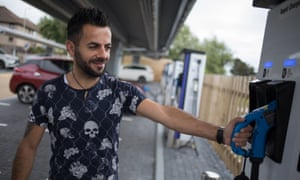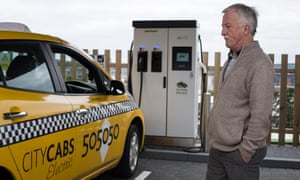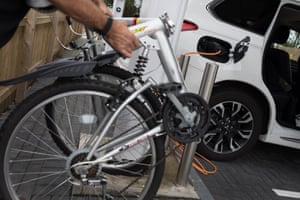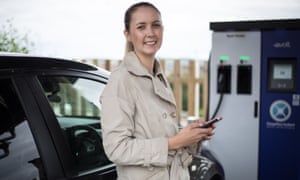Electric bin lorries and solar-powered charging points are aimed at making city cleanest in UK

“They’re marvellous. I just love them.” After nearly 26 years driving a diesel-powered taxi around the streets of Dundee, James Leaburn has switched to an all-electric car, in the bold yellow livery of a classic New York cab.
“They’re quiet, comfortable and the kids just love it because it’s like a New York cab,” said Leaburn as he plugged in at a council-run charging hub. “There’s no servicing, no broken fanbelts, no oil to change and no flat batteries. Just the press of a button and they’re away.”
Dundee, once synonymous with industrial and urban decline, is now at the vanguard of the switch to zero-carbon transport. It already boasts the largest number of electric minicabs anywhere in the UK (134 at the last count), a council-owned network of four solar-powered charging hubs capable of taking 78 cars at a time (with sites for another 60 being built) and the highest number of rapid chargers of any Scottish city. In a few days it will open a rooftop charging hub – solar-powered, of course – at a city-centre multistorey.
Fraser Crichton, the council’s fleet operations manager, is in charge of the strategy. “My ambition is to make Dundee fully electric within 15 years, which is my working lifetime,” he said. “I want my city to be the cleanest in the UK.”

The Scottish government aims to cut the country’s net carbon emissions to zero by 2045 and end sales of new petrol and diesel cars by 2032. On Thursday the Scottish transport secretary, Michael Matheson, said more than 1,000 public charging points had been installed around the country. Scotlandnow has the best network of its kind in the UK by head of population – a claim verified by ZapMap, which charts electric charging points UK-wide.
Dundee city council believes it has the UK’s largest local authority electrified fleet, with 117 electric cars and vans in use. It plans to buy 65 more, replacing its highly polluting diesel bin lorries and road sweepers with electric vehicles, and running subsidised electric minibuses in some of its poorest neighbourhoods.
Crichton said the impetus for championing electric vehicles was Dundee’s serious problem with air pollution. The city was built in the bowl of an eroded volcano and exhaust gases settle over its centre. It has three of the most polluted streets in Scotland.
Shortly before Leaburn arrived at the council’s Princes Street charging hub, where cars charge under canopies carrying solar panels, Abdullah Kamer had pulled in for a brief battery top-up. Kamer drives for Zippy, a local takeaway delivery company that operates a fleet of 11 battery-powered, zero-emission BMW i3s.
The company’s drivers have a reputation for living up to its name, revelling in the electric car’s sharp acceleration. “It’s a good runner in the city centre,” Kamer said. “You can actually enjoy driving it. When I use my diesel car, it’s like driving a tractor.”

David Kidd, after finishing a shift at a nearby M&S, was loading a folding bike into the boot of his plug-in hybrid 4×4, a Mitsubishi Outlander, which was charging nearby. He switched after spending a fortune on diesel for a long drive to Cornwall. The Princes Street site was once a petrol station.
Thanks to his short commute to Fife entirely on battery power, he gets 350 miles per gallon in the Outlander. He parks up in town and takes the folding bike from the boot and pedals into work. “It’s unbelievable,” he said. “It costs nothing to come to my work.”
Despite these endorsements and the Scottish government’s boasts about its charging network, Scotland’s drivers have been slow to take up electric vehicles. Official sales figures show that while Scotland has 8.5% of the UK’s population, only 5.8% of the UK’s ultra low-emission cars are registered in Scotland. That’s 11,607, out of a total of 2.5m cars in Scotland. Meanwhile, bus use has been in long-term decline and CO2 emissions from transport continue to grow.
Elinor Chalmers, a dentist who runs the Electric Vehicle Association Scotland, an owners group, said too many drivers focused on the longer charging time compared with refuelling with petrol or diesel.

“It’s [about] changing the mindset,” said Chalmers, who does not have a charger at home but instead leaves her Nissan Leaf plugged into one of Dundee’s fast-charging hubs once or twice a week during gym visits or shopping. “I’m planning to pop down now to M&S for a sandwich, and by the time I’m back I’m good to go.”
Environment campaigners welcome the shift to electric vehicles, but John Lauder, the deputy chief executive of the sustainable travel charity Sustrans, said far greater effort was needed to cut overall private car use, not just to switch from fossil fuels.
“Electric vehicles are not always carbon neutral, they will not tackle congestion in our towns and cities, they will not improve road safety and they will do nothing to deal with the obesity crisis facing Scotland,” he said. “We need to see a sizeable reduction in shorter urban journeys by car, and we have existing technologies that can be scaled up and rolled out in a far shorter timescale: walking and cycling.”








